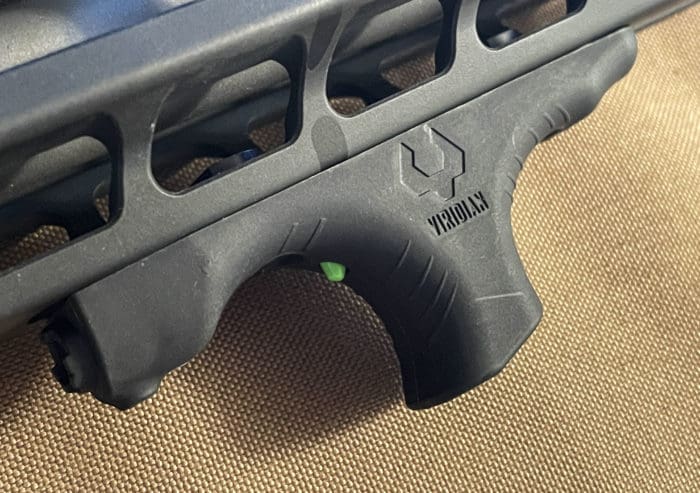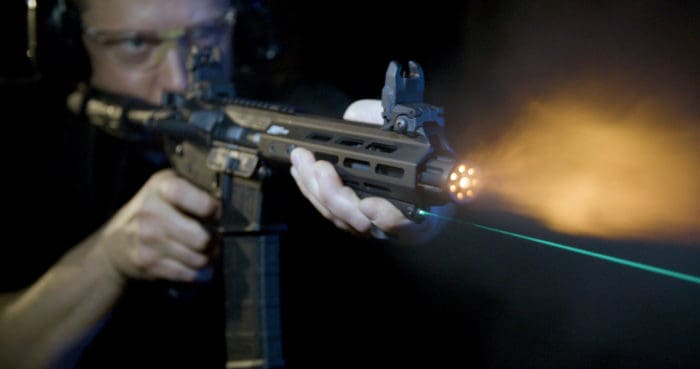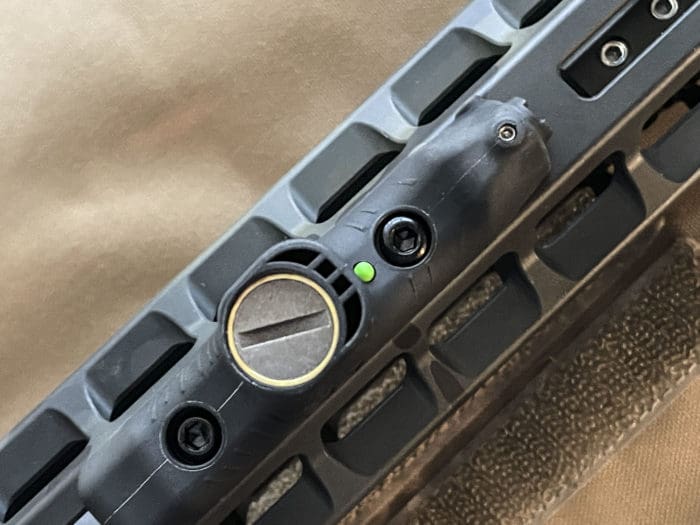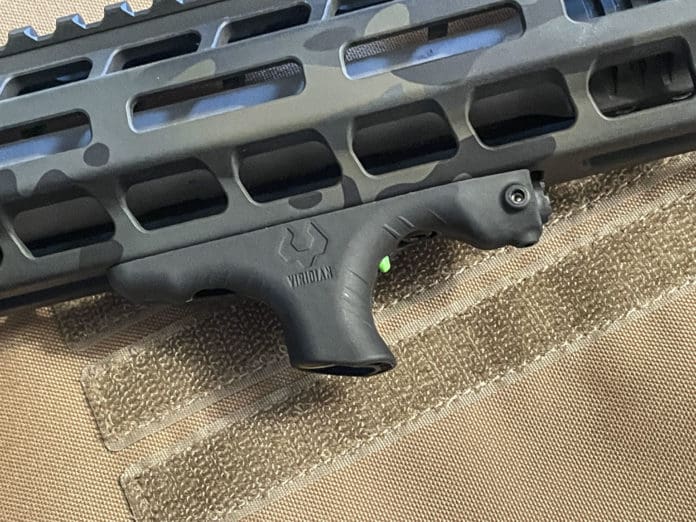The Viridian HS1 laser hand stop falls under the general category of Why the Hell Didn’t Anyone Think of That Sooner™. Incorporating a laser sight into a hand stop seems like the most natural V8 forehead-slapping idea in the gun accessory category.
The HS1 is a simple, intuitive design with a standard M-LOK mount. Don’t worry…if your rifle has a Pic rail-equipped handguard, Viridian makes a Picatinny adapter for the HS1, too.

The HS1 Laser Hand Guard turns on via the protruding electric greed button. There’s no constant-on setting. Press it and it’s on. Let go and it’s off. That’s simple enough that even a Harvard scholar like David Hogg could figure it out.
Plenty of thought went into the HS1’s ergonomics when Viridian designed this thing. If you don’t want to use the laser, you can comfortably grip your rifle with your finger tucked behind it, using the comfortably smooth polymer stop. When you want to illuminate your target, just slide your hand forward slightly and press the green button with your pointing digit. Easy peasy.

The HS1 mounts low enough that most cans won’t interfere with the laser beam. If you have an unusually large suppressor you’re still using, Viridian’s Pic rail adapter will allow you to mount it lower to clear the can.
Unless you’re color blind, you’ve noticed that the HS1 we tested uses a green laser emitter (Viridian makes red and infrared models, too). That’s a good thing as the human eye picks up green light about six times more readily than it does red light. All three models are priced the same and I’m not sure why anyone would choose red over green, but you do you.
The intense green emitter translates into great daytime usability. I was able to easily see targets illuminated in full daylight out to 100 yards. At night, you can paint your targets at 500 yards and beyond (Viridian rates it at 2 miles, but I didn’t test that, nor am I likely to attempt shots with an AR-15 at that range).
 Want some more good news? I have two words for you: Made in America. Uncle Joe would be so proud of Viridian, turning out HS1s right here in the US of A. And we all want to please the Big Guy, don’t we?
Want some more good news? I have two words for you: Made in America. Uncle Joe would be so proud of Viridian, turning out HS1s right here in the US of A. And we all want to please the Big Guy, don’t we?
The HS1’s battery compartment is easily accessible (not to mention water tight…I got it wet and tossed it in the freezer, too) and takes CR 1/3N batteries. Viridian rates the HS1’s battery life at 1.5 hours. That may not sound like much, but with no constant-on use, a battery should easily last for months and months before you need to change it out.
Of course, you’ll have to deal with parallax. I zero’d mine at 50 yards and mentally adjusted from there. It’s not rocket surgery and if your education is sufficient to read this, you can do it, too.
Priced at $129, the Viridian HS1 is a very affordable way to add laser capability to your long gun. For a home defense AR, you really ought to have a light anyway. The HS1 makes it incredibly simple to add laser functionality as well at a very affordable price.





“Unless you’re color blind . . .”
Actually, I’m green color blind. Bummer.
I think 🤔 It’s very heavy gun
Then you need to start doing arm curls…
40 oz curls and my six pack turned into a pony keg. Oh well.
i always wanted a greed button.
Then you’ll need to buy the green laser version. The red version comes with a ren button
Well played, UW. Well played.
Pretty sure I was born with one and these tacticool gunsngadgets ads are continuously pushing my greed button. I find myself buying new rifles just to increase available rail space…
Golly a lazer that close to your hand. I’d be worried I might cut my fingers off.
Well possums have little fingers
Do ostriches even have fingers?
No. That’s why their necks are so long. Evolution for the win.
Called wing tips
AS USUAL, the “information” in this article is W-R-O-N-G-!
Dan makes a big point of “All three models are priced the same” but that is total BS — the price quoted here is for the red laser only — green costs $50 more than the price in the article, and the IR version costs $120 more.
Also, all three versions are significantly cheaper on Amazon than if you use the link given here that pays a kickback to Dan and TTAG
“I zero’d mine at 50 yards and mentally adjusted from there.”
converging zero for a laser on a rifle sucks, and probably the most overall useless type of zero.
Parallel zero is much better with a constant offset at all distances, and not the holds to remember at distances less or greater than the converging zero point (50 yards in your case).
But having the laser on the bottom of the rifle makes it basically useless for a parallel zero because you can’t see the laser dot when aiming down the rifle because the beam view is blocked by the rifle (unless you look off to the sides). I use small ‘pistol’ type lasers, and one laser designated for rifle, mounted on the top rail parallel to the bore either top or slight to the right (the one designated for rifle), that way I always see the dot while aiming down the rifle and the offset will always be the distance between the bore and the laser center (~ 1.5 inches) and I don’t need to remember holds to get a reasonable hit out to at least 300 yards in relation to the zero of the red dot or iron sights zero (I normally use a 50/200 zero on the carbines).
Its different for pistol, the only place to mount the laser most times is below the barrel so that needs a converging zero.
here are the lasers I use on rifles, they all work fine on rifles…
Crimson Trace CMR-206 Rail Master Universal Laser > https://www.crimsontrace.com/products/tactical-lights/rail-master/cmr-206-rail-master-universal-green-laser-sight/01-4620-1.html
Holosun RML Green > https://holosun.com/index/product/detail/id/156.html
LaserMax Green Spartan Laser > https://www.lasermax.com/sps-g.html
SightMark LoPro Mini Green Laser Sight > https://sightmark.com/products/lopro-mini-green-laser-sight (this one made specifically for rifle)
All of them have thousands of rounds on them and have never lost zero.
The Sightmark has up to 18 hours of battery life in continuous use; When I first got it I was a little skeptical ’cause, ya know ‘sightmark ugggg’ historically was not a ‘go to’ for optics, they had some pro0blems, but this was really cheap when I got it and i though “why not, ’cause it seems they are making an effort nowadays to put some decent stuff out”. So I set out to test it and…. I have literally thrown it off buildings on to concrete below, literally frozen it in a block of ice, left it submersed in water in the pool deep end for days, thrown it against walls, beat it with hard objects, abused it – looks worse for wear but it has never stopped working and still holds zero and has thousands of rounds on it now.
You need to be a contributor for TAG… and get paid, too.
“Want some more good news? I have two words for you: Made in America. Uncle Joe would be so proud of Viridian, turning out HS1s right here in the US of A.”
Hmmmm…. https://viridianweapontech.com/
“Viridian® Weapon Technologies is devoted to applying cutting-edge technology to design compact, powerful self-defense products for the civilian, military and law enforcement markets. Viridian is the leader in weapon-mounted technology and responsible for a number of firearm innovations including green and red laser sights, weapon-mounted cameras and several shooting accessories, including the Tacloc® Holsters. Viridian tactical gun lights, weapon accessories and products are proudly designed and built in the USA.”
Designed in the USA, yes. Built in the USA, yes. But built from components made in China and Japan (and sometimes Germany).
According to the Federal Trade Commission, “Made in USA” means that “all or virtually all” the product has been made in America. That is, all significant parts, processing and labor. that go into the product must be of U.S. origin.
the loophole: Parts/material made in other countries that are imported then sourced from an American company are considered “U.S. origin”. Thus a product built (e.g. assembled) in the USA can claim ‘Made in USA’ for their products when in reality the whole thing may physically (in terms of parts and materials) be actually of foreign ‘origination’.
“made in the USA” just means the final product is constructed in the United States, not that it was actually completely made in the USA. Its ‘legal truth’ vs ‘factual truth’
There are no firearms optics/lasers today that are factually truly “made in the USA”. All of them marketed as “made in the USA” use parts/materials that originated in foreign countries and are simply ‘assembled’ in the USA. Its simply too expensive to manufacture all the parts needed for firearms optics and lasers in the USA, if that were to happen firearms optics/lasers would be cost a lot more than they do now in the U.S.
Interesting comment on the price. Every one of my three Viridian LS-1’s are green and they were more expensive than the red. Still liked the price, and I too go for the parallel setting vs converging sinc my sight is above the barrel and the laser is below the barrel, red dot is aligned for 100 yds and the half to 5/8′ laser below barrel boresight is not enough diff to matter. Having a red dot sight and a green dot laser makes it impossible to confuse the two when targeting.
Comments are closed.